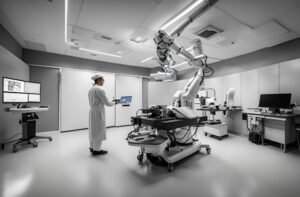
In 2045, the world witnessed a groundbreaking revolution in medicine that forever altered the landscape of healthcare. The advent of robotic surgery promised error-free procedures, marking not just an evolution but a complete transformation in medical practice. This story of innovation, adaptation, and unforeseen consequences highlights the profound impact of this technological marvel on humanity.

The genesis of this revolution began with the creation of the MedBot 3000, a sophisticated robotic surgeon designed by an international consortium of engineers, doctors, and AI specialists. Equipped with advanced artificial intelligence, the MedBot 3000 could learn from every surgery it performed, analyze millions of medical records in seconds, predict complications before they arose, and execute delicate procedures with unparalleled precision. The first successful operation performed by the MedBot 3000 was a heart transplant, completed in record time and without a single error. The patient, a middle-aged man named John, recovered swiftly and without complications, heralding the dawn of a new era.
As the MedBot 3000 became more widely adopted, hospitals around the world saw a drastic reduction in surgical errors. Complications from infections, miscalculations, and human fatigue became relics of the past. The success rates of surgeries skyrocketed, and patients experienced shorter recovery times. The healthcare industry was transformed almost overnight. Surgeons, once revered as the pinnacle of medical expertise, found their roles shifting. They became overseers, supervising the robots to ensure smooth operations and intervening only in the rarest of circumstances.
The benefits to society were immense. With the reduction in surgical errors, healthcare costs plummeted. Insurance premiums decreased, and access to quality medical care improved globally. Remote areas, previously underserved due to a lack of skilled surgeons, now had access to top-tier medical procedures through mobile robotic units. The global health index improved, and life expectancy increased. The MedBot 3000 became a symbol of hope and progress, a testament to human ingenuity.
However, this technological utopia was not without its challenges. The rapid adoption of robotic surgery led to a significant displacement of the surgical workforce. Thousands of surgeons found themselves redundant, their skills rendered obsolete by the infallible precision of the MedBot 3000. Medical schools saw a sharp decline in applicants for surgical programs, as the allure of becoming a surgeon faded. The medical community faced an identity crisis, grappling with the ethical implications of a future where human touch was no longer needed in the operating room.

Moreover, the reliance on robotic surgery raised concerns about cybersecurity. The MedBot 3000, like all technology, was vulnerable to hacking. The potential for malicious actors to disrupt surgeries or manipulate outcomes became a looming threat. Governments and healthcare institutions invested heavily in cybersecurity measures, creating a new frontier in the battle to protect patient safety. The once unthinkable scenario of a hacked surgery became a chilling possibility that kept many awake at night.
Despite these challenges, the benefits of robotic surgery continued to outweigh the risks. The MedBot 3000 evolved, incorporating new advancements in AI and machine learning. It began to assist in diagnostics, predicting illnesses before symptoms appeared and suggesting personalized treatment plans. The integration of robotic surgery with other medical technologies, such as nanobots and gene editing, opened new horizons in the fight against diseases like cancer and genetic disorders.
Humanity, as it always does, adapted. Surgeons transitioned into new roles, becoming experts in robotic maintenance, programming, and oversight. Medical education evolved, focusing on the integration of technology with human expertise. Ethical frameworks were developed to address the new realities of a tech-driven healthcare system. Society learned to balance the marvels of technology with the irreplaceable value of human compassion and judgment.
In the end, the story of robotic surgery and the MedBot 3000 is one of progress and adaptation. It is a tale of how humanity harnessed the power of technology to overcome its limitations, yet also a reminder of the importance of vigilance and ethical consideration. The world became a healthier place, but it also learned that even in an age of machines, the human spirit remains at the heart of progress.




